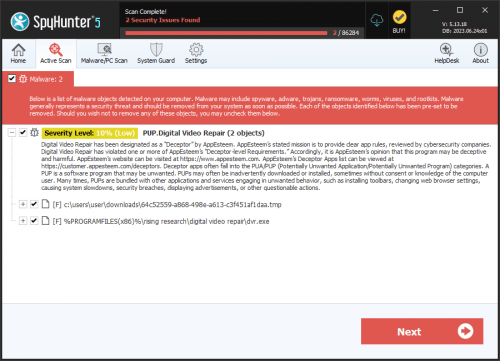Repair Ransomware
During their analysis of potential malware threats, cybersecurity researchers came across a malicious program known as Repair. This program functions as ransomware by encrypting data on infected systems. Upon infiltration, Repair locks numerous files and alters their original filenames by appending a '.repair' extension. For example, a file named '1.png' would appear as '1.png.repair,' and '2.pdf' would become '2.pdf.repair,' and so on.
Once the encryption process is complete, Repair generates an HTML file named 'How_to_back_files.html' on the compromised system. This file contains the ransom note from the attackers, which demands payment for decryption. Additionally, Repair employs double extortion tactics by threatening victims with the exposure of their data. This particular ransomware variant is associated with the MedusaLocker Ransomware family.
The Repair Ransomware Extorts Victims by Taking Data Hostage
Repair's ransom note indicates that this particular ransomware primarily targets businesses rather than individual home users. The note explicitly mentions that files within the company network have been encrypted, and sensitive or personal data has been extracted by the attackers. It emphasizes that only the cybercriminals possess the capability to unlock the encrypted files. Any attempts by the victim to rename, modify, or manually decrypt the files are cautioned against, as they could irreversibly corrupt the data.
To initiate the decryption process, victims are required to pay a ransom. Failure to comply with this demand may result in the stolen data being leaked or sold by the attackers. Additionally, the ransom amount increases if contact with the cybercriminals is not initiated within 72 hours. Before making the payment, victims are allowed to test the decryption on up to three less critical files.
Information security experts caution that decryption without the involvement of the attackers is typically impractical. Exceptions to this rule are rare and usually occur in cases where the ransomware is fundamentally flawed.
Furthermore, there are no guarantees that cybercriminals will provide the promised decryption keys or software even after receiving payment. Therefore, it is strongly advised against acquiescing to their demands, as doing so not only fails to guarantee file recovery but also perpetuates criminal activities.
While removing Repair ransomware from the operating system prevents further data encryption, it does not restore files that have already been affected by the ransomware.
Take Measures to Safeguard Your Data and Devices from Malware Attacks
Safeguarding data and devices from malware attacks requires a multifaceted approach that encompasses both preventive and responsive measures. Here are some key steps users can take:
- Keep Software Updated: Regularly update operating systems, software applications, and antivirus programs to patch vulnerabilities and protect against known exploits. Many malware attacks exploit outdated software.
- Use Strong Passwords: Always use unique passwords for all accounts, including email, social media and online banking. Consider the benefits of utilizing a password manager to generate and store strong passwords securely.
- Enable Two-Factor Authentication (2FA): Implement 2FA when possible to maximize the security of accounts. This ensures that even if a password is compromised, a complementary verification step is required for access.
- Exercise Caution with Email: Be cautious of unsolicited emails, especially those containing attachments or links from unknown senders. Avoid clicking on dubious links or downloading attachments from emails that seem suspicious or unexpected.
- Backup Data Regularly: Maintain regular backups of necessary files and other data to an external storage device or cloud service. Make sure that the backups are stored securely and are not directly accessible from the network to prevent them from being compromised in a malware attack.
- Use Security Software: Install and regularly update reputable anti-malware software on all devices. These programs can detect and remove malware threats, as well as provide real-time protection against new threats.
- Implement Network Security Measures: Use firewalls, intrusion detection systems (IDS), and intrusion prevention systems (IPS) to monitor and filter network traffic for suspicious activity. Segment networks to limit the spread of malware in the event of a breach.
- Educate Users: Bring forth training and awareness programs to educate users about the risks of malware and how to identify potential threats. Teach them to recognize phishing emails, suspicious links, and other common tactics used by cybercriminals.
- Regularly Scan for Malware: Conduct regular malware scans on all devices to detect and remove any unsafe software that may have slipped past initial defenses.
By following these measures, users can significantly enhance the security of their data and devices, diminishing the risk of enduring malware attacks.
The ransom note generated by the Repair Ransomware reads:
'YOUR PERSONAL ID:
/!\ YOUR COMPANY NETWORK HAS BEEN PENETRATED /!\
All your important files have been encrypted!Your files are safe! Only modified. (RSA+AES)
ANY ATTEMPT TO RESTORE YOUR FILES WITH THIRD-PARTY SOFTWARE
WILL PERMANENTLY CORRUPT IT.
DO NOT MODIFY ENCRYPTED FILES.
DO NOT RENAME ENCRYPTED FILES.No software available on internet can help you. We are the only ones able to
solve your problem.We gathered highly confidential/personal data. These data are currently stored on
a private server. This server will be immediately destroyed after your payment.
If you decide to not pay, we will release your data to public or re-seller.
So you can expect your data to be publicly available in the near future..We only seek money and our goal is not to damage your reputation or prevent
your business from running.You will can send us 2-3 non-important files and we will decrypt it for free
to prove we are able to give your files back.Contact us for price and get decryption software.
email:
suntorydots@tutanota.com
suntorydots@outlook.comTo contact us, create a new free email account on the site: protonmail.com
IF YOU DON'T CONTACT US WITHIN 72 HOURS, PRICE WILL BE HIGHER.Tor-chat to always be in touch:'

